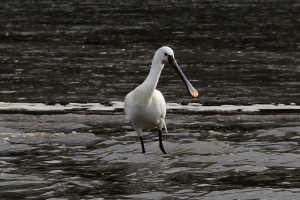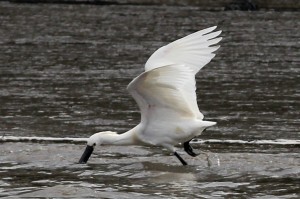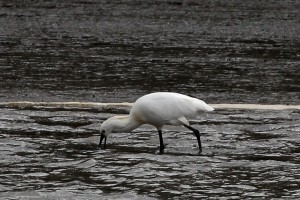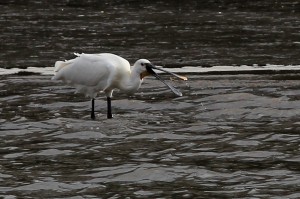Observations on the feeding mechanisms of Eurasian Spoonbill.
Bruce Taggart (reproduced from CBWPS ‘Palores’ Spring 2013)
The Eurasian Spoonbill is a rare passage migrant and winter visitor to Cornwall, but the estuaries of the River Tamar complex including the River Lynher are regular haunts, with up to seven individuals wintering in recent years. Birds usually arrive in November and remain until February / March. Sightings of ringed birds indicate that most, if not all originate from the breeding population in the Netherlands which in 2004 numbered around 1500 breeding pairs. Since 2006 I have been running bird watching cruises on the rivers and we have observed Spoonbills on over 30 occasions, often foraging on the flooding tide. They favour the lower Tamar, below Kingsmill Lake and the confluence with the River Tavy and on the River Lynher, usually east of Wacker Quay. At high tide they roost either on Beggar’s (Rat) Island or on areas of saltmarsh further up the Lynher or in Kingsmill Lake.
Spoonbills are seen foraging in shallow water, usually between 100mm and 450mm. They walk forward with the bill tip submerged and held slightly open with a side to side sweeping action. Once prey is detected, the bill snaps shut and the head is jerked back throwing the item into the throat. (This is because spoonbills have relatively short tongues in relation to their bill length and are unable to manipulate prey prior to swallowing). BWP lists Spoonbill prey items as mainly insects and their larvae, especially water beetles, dragonflies, caddis flies, small fish, amphibians, aquatic snails, and some vegetation. However, most of these may be associated with fresh water, rather than the brackish or saline conditions of an estuary.
So what are the Spoonbills eating and how do they detect prey items? Some authorities’ state that it is purely tactile, the wider part of the bill acting as a sieve to extract small prey from the sediments, similar to Shoveler. This is unlikely to be the case as the mandibles lack the required lamellae. Our observations indicate that prey is caught in the water above the sediment and is more likely to consist of fish, shrimps and marine worms.
Weihs & Katzir(1994) hypothesised that the shape of the bill acts as a hydrofoil over the substrate, lifting prey into the water that would be captured during the following sweep. They created this mainly on observation of captive spoonbills. They assumed the fact that the inner profile of the upper mandible was concave; shedding a vortex over the mud and the bill was held close to the bottom substrate irrespective of water depth. Molluscs in particular would be caught in this way.
Conversely I tend to agree with Swennen and Yu (2008) who rejected this idea centred upon three parameters. Firstly their analysis of prey size and type; fish and shrimps would immediately swim away if disturbed. Secondly, bill shape; the upper mandible is in fact convex not concave and thirdly the height the bill was held above the substrate, often higher than required to create sufficient disturbance to the substrate.
 We have also observed Spoonbills actively chasing prey in the water. Considering the turbid nature of estuaries they must rely on senses other than sight to find prey. There have several recent papers describing some birds (notably waders and kiwi) ability to detect prey by picking up vibrations, termed ‘remote touch’. These birds possess a honeycomb of sensory pits within the bone of the bill tip packed with pressure sensitive mechanoreceptive nerve endings. Cunningham et al (2010) identified similar structures in ibises and spoonbills with the latter having up to 20,000 of these pits compared to several hundred in other species. This suggests Spoonbills rely heavily on remote touch to detect prey.
We have also observed Spoonbills actively chasing prey in the water. Considering the turbid nature of estuaries they must rely on senses other than sight to find prey. There have several recent papers describing some birds (notably waders and kiwi) ability to detect prey by picking up vibrations, termed ‘remote touch’. These birds possess a honeycomb of sensory pits within the bone of the bill tip packed with pressure sensitive mechanoreceptive nerve endings. Cunningham et al (2010) identified similar structures in ibises and spoonbills with the latter having up to 20,000 of these pits compared to several hundred in other species. This suggests Spoonbills rely heavily on remote touch to detect prey.
It has also been suggested that birds use electroreception to obtain food. This is the ability to detect naturally occurring electric fields possibly to the microvolt or even nanovolt (one thousand millionth) capacity. Duck-billed Platypus have a sophisticated electroreception system whereby they can detect and identify prey with the help of specialised receptors in the bill. It is probable that future research will find similar systems in birds. The fact that Spoonbills are hunting in water supports the electroreception theory. I suspect that when a bird is chasing prey through turbid water it knows exactly the identity of what it’s following and how it is likely to behave – whether it will swim away or hide in the mud. That would greatly increase its chances of capture.
One final point. Having detected the prey and it has touched the open mandibles the reaction time must be quick. I couldn’t find any data for Spoonbills but experiments with American Wood Ibis (in the same family) has shown that the bill snaps shut in around 25 milliseconds ie 1/40th second.
There is a tendency to compare birds’ senses to those of humans. However in some areas birds are far more advanced. It is well known they are able to sense the earth’s magnetic field and see ultraviolet light and as these notes illustrate new senses are being discovered. The basis for many of these new discoveries is observation combined with science. So next time you see a bird, don’t just look at it, but watch and record its behaviour.
Acknowledgements
Thanks to all participants on boat trips who have questioned and stimulated discussion about feeding Spoonbills and especially to Charlie Bird for supplying the excellent accompanying images and to Chris for patiently enduring my birding obsession.
References
Cramp, S. and Simmons, K. E. L. 1977. Handbook of the birds of Europe, the Middle East, and North Africa: the birds of the western Palearctic, 1. Oxford University Press, Oxford
Cunningham, S.J., Alley, M.R., Castro, I., Potter, M.A., Cunningham, M., Pyne, M.J. 2010. Bill morphology of ibises suggests a remote-tactile sensory system for prey detection. The Auk 127(2):308-316.
Swennen, C. and Yu, Y. T. 2005. Food and feeding behaviour of the black-faced spoonbill. Waterbirds 28: 19–27.
Swennen, C. and Yu, Y.-t. 2008. Bill sweeping in spoonbills Platalea: no evidence for an effective suction force at the tip. Journal of Avian Biology, 39: 3–6. doi: 10.1111/j.0908-8857.2008.04299.x
Weihs, D. and Katzir, G. 1994. Bill sweeping in the spoonbill, Platalea leucorodia: evidence for a hydrodynamic function. Anim. Behav. 47: 649–654.



